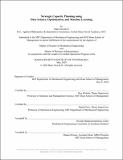| dc.contributor.advisor | Roy Welsch and Daniel Frey. | en_US |
| dc.contributor.author | Nowak, Hans,II(Hans Antoon) | en_US |
| dc.contributor.other | Sloan School of Management. | en_US |
| dc.contributor.other | Massachusetts Institute of Technology. Department of Mechanical Engineering. | en_US |
| dc.contributor.other | Leaders for Global Operations Program. | en_US |
| dc.date.accessioned | 2020-09-03T15:53:44Z | |
| dc.date.available | 2020-09-03T15:53:44Z | |
| dc.date.copyright | 2020 | en_US |
| dc.date.issued | 2020 | en_US |
| dc.identifier.uri | https://hdl.handle.net/1721.1/126914 | |
| dc.description | Thesis: M.B.A., Massachusetts Institute of Technology, Sloan School of Management, in conjunction with the Leaders for Global Operations Program at MIT, May, 2020 | en_US |
| dc.description | Thesis: S.M., Massachusetts Institute of Technology, Department of Mechanical Engineering, in conjunction with the Leaders for Global Operations Program at MIT, May, 2020 | en_US |
| dc.description | Cataloged from the official PDF of thesis. | en_US |
| dc.description | Includes bibliographical references (pages 101-104). | en_US |
| dc.description.abstract | Raytheon's Circuit Card Assembly (CCA) factory in Andover, MA is Raytheon's largest factory and the largest Department of Defense (DOD) CCA manufacturer in the world. With over 500 operations, it manufactures over 7000 unique parts with a high degree of complexity and varying levels of demand. Recently, the factory has seen an increase in demand, making the ability to continuously analyze factory capacity and strategically plan for future operations much needed. This study seeks to develop a sustainable strategic capacity optimization model and capacity visualization tool that integrates demand data with historical manufacturing data. Through automated data mining algorithms of factory data sources, capacity utilization and overall equipment effectiveness (OEE) for factory operations are evaluated. Machine learning methods are then assessed to gain an accurate estimate of cycle time (CT) throughout the factory. Finally, a mixed-integer nonlinear program (MINLP) integrates the capacity utilization framework and machine learning predictions to compute the optimal strategic capacity planning decisions. Capacity utilization and OEE models are shown to be able to be generated through automated data mining algorithms. Machine learning models are shown to have a mean average error (MAE) of 1.55 on predictions for new data, which is 76.3% lower than the current CT prediction error. Finally, the MINLP is solved to optimality within a tolerance of 1.00e-04 and generates resource and production decisions that can be acted upon. | en_US |
| dc.description.statementofresponsibility | by Hans Nowak II. | en_US |
| dc.format.extent | 123 pages | en_US |
| dc.language.iso | eng | en_US |
| dc.publisher | Massachusetts Institute of Technology | en_US |
| dc.rights | MIT theses may be protected by copyright. Please reuse MIT thesis content according to the MIT Libraries Permissions Policy, which is available through the URL provided. | en_US |
| dc.rights.uri | http://dspace.mit.edu/handle/1721.1/7582 | en_US |
| dc.subject | Sloan School of Management. | en_US |
| dc.subject | Mechanical Engineering. | en_US |
| dc.subject | Leaders for Global Operations Program. | en_US |
| dc.title | Strategic capacity planning using data science, optimization, and machine learning | en_US |
| dc.type | Thesis | en_US |
| dc.description.degree | M.B.A. | en_US |
| dc.description.degree | S.M. | en_US |
| dc.contributor.department | Sloan School of Management | en_US |
| dc.contributor.department | Massachusetts Institute of Technology. Department of Mechanical Engineering | en_US |
| dc.contributor.department | Leaders for Global Operations Program | en_US |
| dc.identifier.oclc | 1191623969 | en_US |
| dc.description.collection | M.B.A. Massachusetts Institute of Technology, Sloan School of Management | en_US |
| dc.description.collection | S.M. Massachusetts Institute of Technology, Department of Mechanical Engineering | en_US |
| dspace.imported | 2020-09-03T15:53:44Z | en_US |
| mit.thesis.degree | Master | en_US |
| mit.thesis.department | Sloan | en_US |
| mit.thesis.department | MechE | en_US |
